Laws and Trends of the Evolution of Traditional Villages in Plane Pattern
Abstract
1. Introduction
2. Data and Methods
2.1. Data of Rural Evolution
2.2. Data Processing
- (1)
- Village map registration was completed by referring to satellite remote sensing images. Most of the sample village maps were highly accurate with small deviations, because of achievements in field surveying and mapping.
- (2)
- The data for residential land patches in each map were extracted.
- (3)
- The multi-temporal layouts of the residential land patches in each village were reconstructed, using records in the corresponding village studies.
- (4)
- The boundaries for the village layout in each development phase were generated using data management tools and cartography tools in ArcMap. To avoid the influence of the specific form of those buildings on the boundary generation, for a certain village, the gravity center of each building plaque was extracted. This constituted the point cluster of the village. Then, the outer boundary of the point cluster was generated using ArcMap; this was guided by the principle that any line segment connecting two points on the boundary should be shorter than the threshold value (which is accurate to the meter). The threshold value was the minimum value needed to have the boundary enclose all points. Finally, the boundary, expressed by a polyline, was softened using the smoothing algorithm of Bezier Interpolation, embedded in the Smooth Line Tool of ArcMap. When the fitting curve intersected, the threshold value was reduced, and multi-boundaries were regenerated to enclose a multi-cluster of points (Figure 4).
2.3. Methods for Spatial Analysis
3. Results and Analysis
3.1. The Morphological Evolution of the Sample Villages
3.2. The Metric Data Changes in the Spatial Sprawl
3.2.1. The Data Changes of the Metrics about Patch Texture
3.2.2. The Data Changes of the Metrics at the Macro-Morphology Level
4. Discussions and Conclusions
- (1)
- In modern China, especially since the founding of the PRC, there has been a significant break in the stability of rural spatial development.
- (2)
- In comparison with large villages, most small and medium-sized villages have maintained a relatively stable spatial texture during their development.
- (3)
- The mean and variance of the patch area, and the Euclidean nearest-neighbor distance, are correlated in some cases.
- (4)
- The mode of rural expansion may be relevant to limitations in the total area of growth.
- (5)
- The complexity of the village boundary fluctuated and approached the equilibrium level in the process of village development.
- (6)
- The growth threshold of a single building patch may be about 100 m2 and not more than 150 m2 in general.
Author Contributions
Funding
Conflicts of Interest
References
- Miller, G.T. Living in the Environment; Wadsworth Publishing Company: Belmont, CA, USA, 1990. [Google Scholar]
- Zhou, C.; Sun, Z.; Xie, Y. Research on Geographic Cellular Automata; China Science Publishing & Media Ltd.: Beijing, China, 2000. [Google Scholar]
- White, R.; Engelen, G. Cellular automata and fractal urban form: A cellular modelling approach to the evolution of urban land-use patterns. Environ. Plan. A 1993, 25, 1175–1199. [Google Scholar] [CrossRef]
- Ward, D.P.; Murray, A.T.; Phinn, S.R. A stochastically constrained cellular model of urban growth. Comput. Environ. Urban Syst. 2000, 24, 539–558. [Google Scholar] [CrossRef]
- Molnar, C. Interpretable Machine Learning: A Guide for Making Black Box Models Explainable. Bookdown, 2020. Available online: https://christophm.github.io/interpretable-ml-book/ (accessed on 7 April 2020).
- Doshi-Velez, F.; Kim, B. Towards a rigorous science of interpretable machine learning. arXiv 2017, arXiv:1702.08608. [Google Scholar]
- Berberoğlu, S.; Akin, A.; Clarke, K.C. Cellular automata modeling approaches to forecast urban growth for Adana, Turkey: A comparative approach. Landsc. Urban Plan. 2016, 153, 11–27. [Google Scholar] [CrossRef]
- Lagarias, A. Urban sprawl simulation linking macro-scale processes to micro-dynamics through cellular automata, an application in Thessaloniki, Greece. Appl. Geogr. 2012, 34, 146–160. [Google Scholar] [CrossRef]
- Weng, Y. Spatiotemporal changes of landscape pattern in response to urbanization. Landsc. Urban Plan. 2007, 81, 341–353. [Google Scholar] [CrossRef]
- Porter-Bolland, L.; Ellis, E.A.; Gholz, H.L. Land use dynamics and landscape history in La Montaña, Campeche, Mexico. Landsc. Urban Plan. 2007, 82, 198–207. [Google Scholar] [CrossRef]
- Gustafson, E.J. Quantifying landscape spatial pattern: What is the state of the art? Ecosystems 1998, 1, 143–156. [Google Scholar] [CrossRef]
- Herold, M.; Couclelis, H.; Clarke, K.C. The role of spatial metrics in the analysis and modeling of urban land use change. Comput. Environ. Urban Syst. 2005, 29, 369–399. [Google Scholar] [CrossRef]
- Guo, C.; Schwarz, N.; Buchmann, C. Exploring the added value of population distribution indicators for studies of European urban form. Appl. Spat. Anal. Policy 2018, 11, 439–463. [Google Scholar] [CrossRef]
- Chust, G.; Ducrot, D.; Pretus, J.L. Land cover mapping with patch-derived landscape indices. Landsc. Urban Plan. 2004, 69, 437–449. [Google Scholar] [CrossRef]
- Yang, Q.; Duan, X.; Jin, Z.; Wang, L. Spatial scenario simulation and landscape ecological effect based on construction land expansion of Nantong city. Sci. Geogr. Sin. 2017, 37, 528–536. [Google Scholar]
- Liu, X.; Ma, L.; Li, X.; Ai, B.; Li, S.; He, Z. Simulating urban growth by integrating landscape expansion index (LEI) and cellular automata. Int. J. Geogr. Inf. Sci. 2014, 28, 148–163. [Google Scholar] [CrossRef]
- Herold, M.; Goldstein, N.C.; Clarke, K.C. The spatiotemporal form of urban growth: Measurement, analysis and modeling. Remote Sens. Environ. 2003, 86, 286–302. [Google Scholar] [CrossRef]
- Deng, J.S.; Wang, K.; Hong, Y.; Qi, J. Spatio-temporal dynamics and evolution of land use change and landscape pattern in response to rapid urbanization. Landsc. Urban Plan. 2009, 92, 187–198. [Google Scholar] [CrossRef]
- Leclerc, E.; Wiersma, Y. Assessing post-industrial land cover change at the Pine Point Mine, NWT, Canada using multi-temporal Landsat analysis and landscape metrics. Environ. Monit. Assess. 2017, 189, 1–19. [Google Scholar] [CrossRef]
- Wang, C.; Wang, Y.; Wang, R.; Zheng, P. Modeling and evaluating land-use/land-cover change for urban planning and sustainability: A case study of Dongying city, China. J. Clean. Prod. 2018, 172, 1529–1534. [Google Scholar] [CrossRef]
- Liu, X.; Li, X.; Chen, Y.; Tan, Z.; Li, S.; Ai, B. A new landscape index for quantifying urban expansion using multi-temporal remotely sensed data. Landsc. Ecol. 2010, 25, 671–682. [Google Scholar] [CrossRef]
- Onuoha, H.U.; Hu, S.; Odemerho, F.O. Analysis of urban growth pattern in Edwardsville/Glen Carbon, Illinois, using remote sensing, population change data, and landscape expansion index. Pap. Appl. Geogr. 2018, 4, 72–82. [Google Scholar] [CrossRef]
- Zhang, A.; Xia, C.; Lin, J.; Chu, J. Landscape evolution characteristic index and application. Prog. Geogr. 2018, 37, 811–822. [Google Scholar]
- Qian, M.; Pu, L.; Zhang, J. Urban spatial morphology evolution in Suzhou-Wuxi-Changzhou region based on improved landscape expansion index. Sci. Geogr. Sin. 2015, 35, 314–321. [Google Scholar]
- Wu, P.; Zhou, D.; Gong, H. A new landscape expansion index: Definition and quantification. Acta Ecol. Sin. 2012, 32, 4270–4277. [Google Scholar]
- Jiao, L.; Liu, J.; Xu, G.; Dong, T.; Gu, Y.; Zhang, B.; Liu, Y.; Liu, X. Proximity expansion index: An improved approach to characterize evolution process of urban expansion. Comput. Environ. Urban Syst. 2018, 70, 102–112. [Google Scholar] [CrossRef]
- Jiao, L.; Mao, L.; Liu, Y. Multi-order landscape expansion index: Characterizing urban expansion dynamics. Landsc. Urban Plan. 2015, 137, 30–39. [Google Scholar] [CrossRef]
- Guo, P.; Ding, W. Methodological Significance of Morphological Typology in Village Renewal and Protection: Chinese Traditional Village Conservation Forum; China Agricultural Science and Technology Press: Nanjing, China, 2017. [Google Scholar]
- Duan, W.; Lv, H. Growing villages—A strategic exploration of spatial construction in a common mountain village. In Proceedings of the 2013 Annual Conference of Urban Planning in China, Qingdao, China, 16–18 November 2013. [Google Scholar]
- Duan, J.; Gong, K.; Chen, X.; Zhang, X. Spatial Research (Spatial Analysis the World Cultural Heritage Village of Xidi); Southeast University Press: Nanjing, China, 2016. [Google Scholar]
- Zhang, A.; Chen, Y.; Chen, Y. Research on form evolution of Hakka rural settlement based the social transformation—Take Bailu village as an example. J. Gannan Norm. Univ. 2017, 38, 92–97. [Google Scholar]
- Zong, L.; Jiao, Y.; Li, S.; Zhang, H.; Zhang, H.; He, Y.; Niu, L. The rural settlement landscape and its evolution in Hani rice terrace culture landscape areas: A case study of the Quanfuzhuang middle village, Yuanyang County, Yunnan. Trop. Geogr. 2014, 34, 66–75. [Google Scholar]
- Chen, Z.; Li, Q. Three Villages in Meixian County; Tsinghua University Press: Beijing, China, 2007. [Google Scholar]
- Liu, L. Researches of Hakka in Shenzhen; Haitian Press: Shenzhen, China, 2013. [Google Scholar]
- He, X. The logic of farmers’ action and the regional difference in village administration. Open Times 2007, 19, 105–121. [Google Scholar]
- Magle, S.B.A.T. A comparison of metrics predicting landscape connectivity for a highly interactive species along an urban gradient in Colorado, USA. Landsc. Ecol. 2009, 24, 267–280. [Google Scholar] [CrossRef]
- Qu, Y.; Jiang, G.; Yang, Y.; Zheng, Q.; Li, Y.; Ma, W. Multi-scale analysis on spatial morphology differentiation and formation mechanism of rural residential land: A case study in Shandong Province, China. Habitat Int. 2018, 71, 135–146. [Google Scholar]
- Wang, X.; He, X.; Ge, D.; Gong, S. Review on literature of historical settlement geography in China. Trop. Geogr. 2012, 32, 107–112. [Google Scholar]
- Yang, R.; Xu, Q.; Long, H. Spatial distribution characteristics and optimized reconstruction analysis of China’s rural settlements during the process of rapid urbanization. J. Rural Stud. 2016, 47, 413–424. [Google Scholar] [CrossRef]
- Pu, X. Quantitative Method for the Study on Plane Form of Traditional Rural Settlements; Southeast University Press: Nanjing, China, 2013. [Google Scholar]
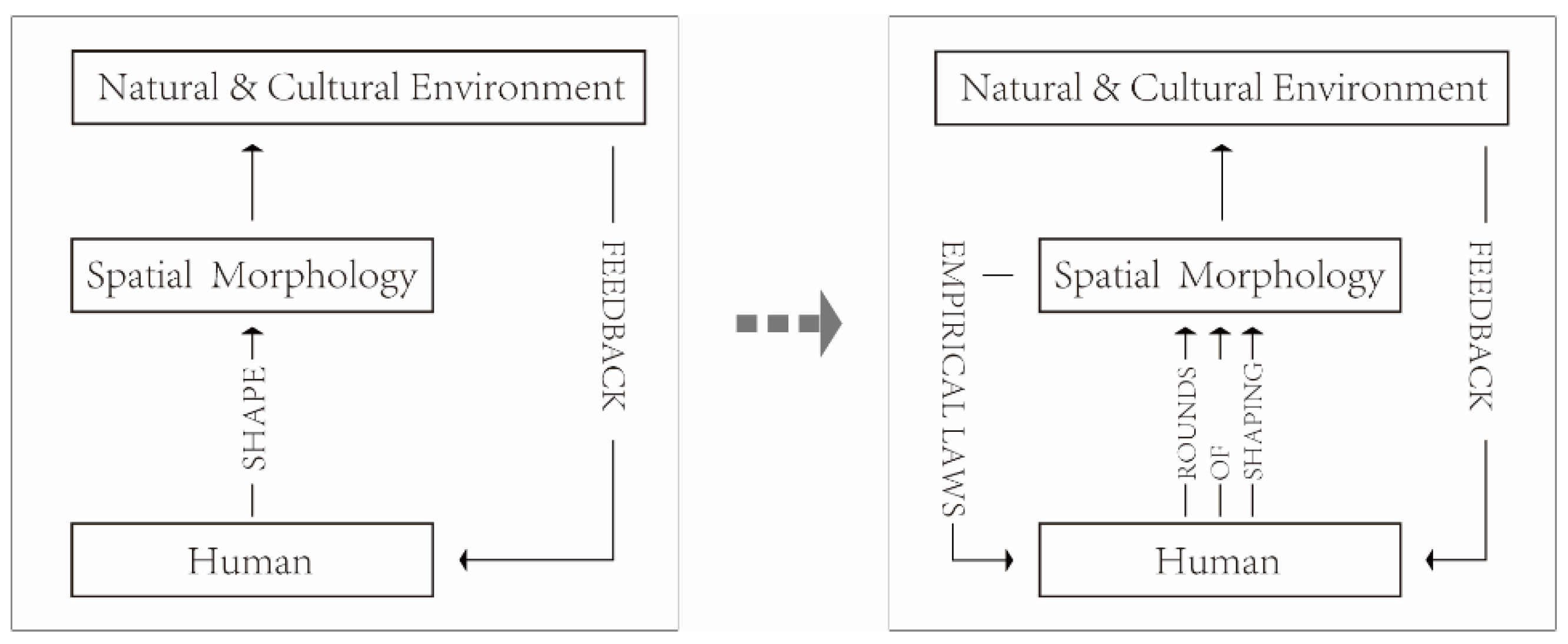
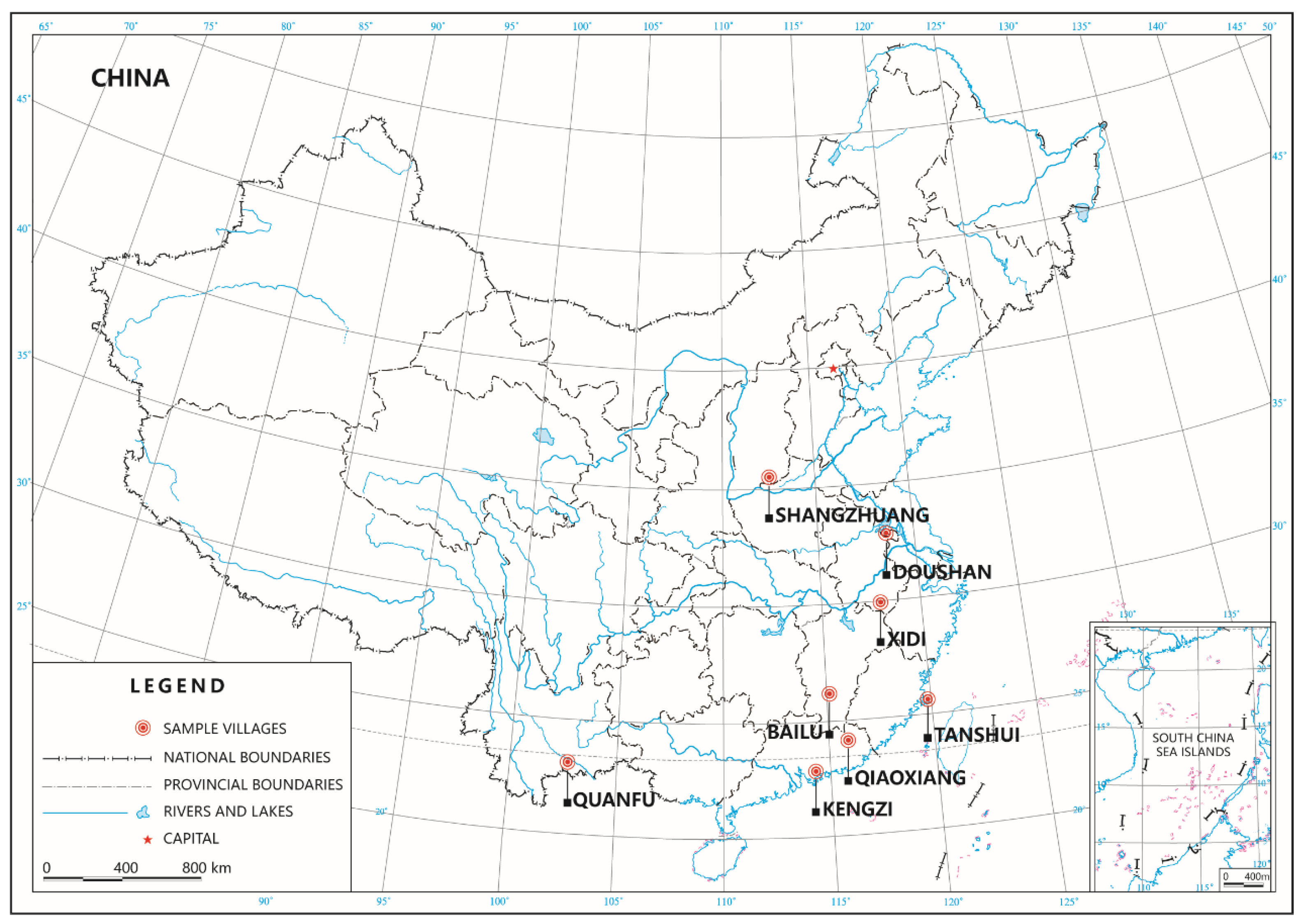
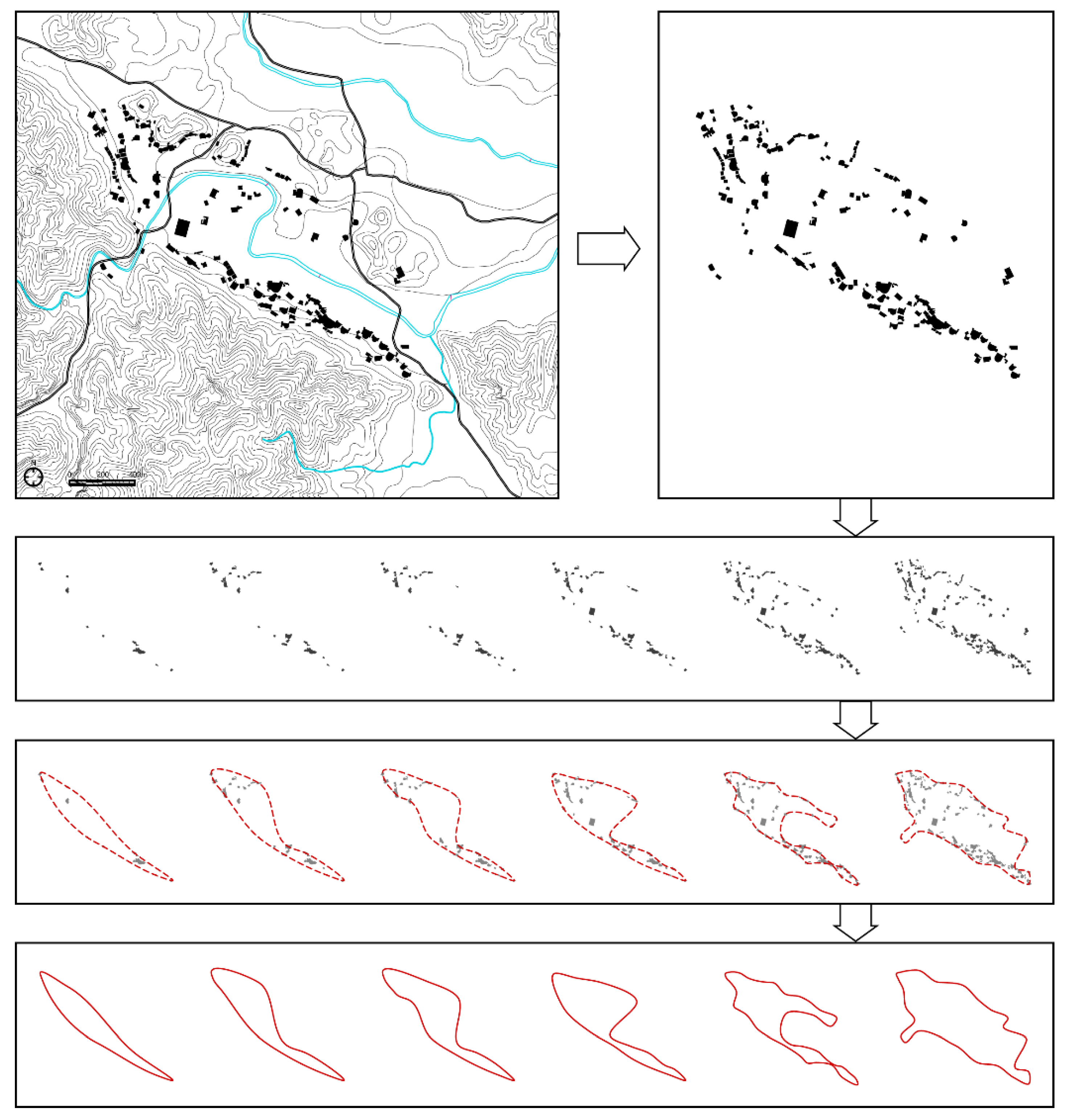

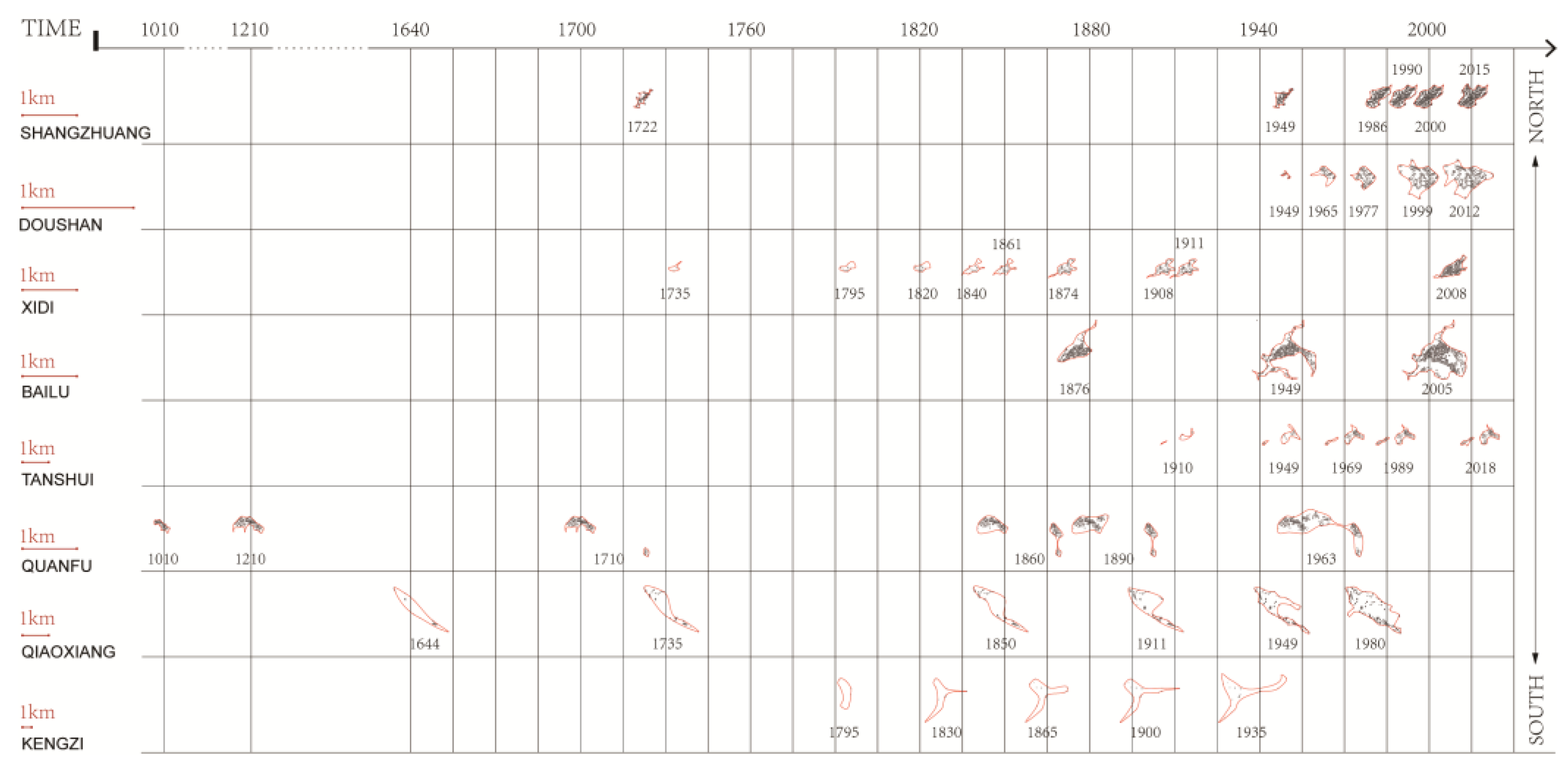
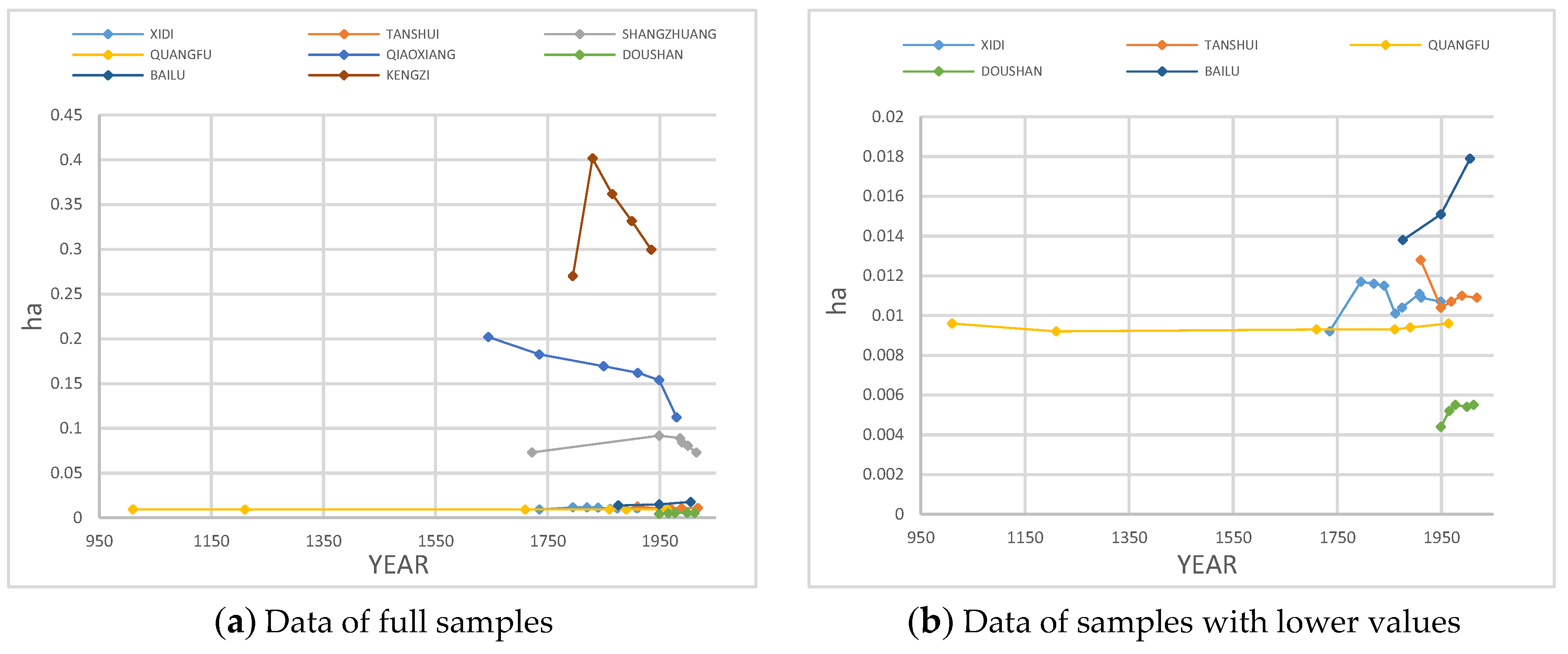

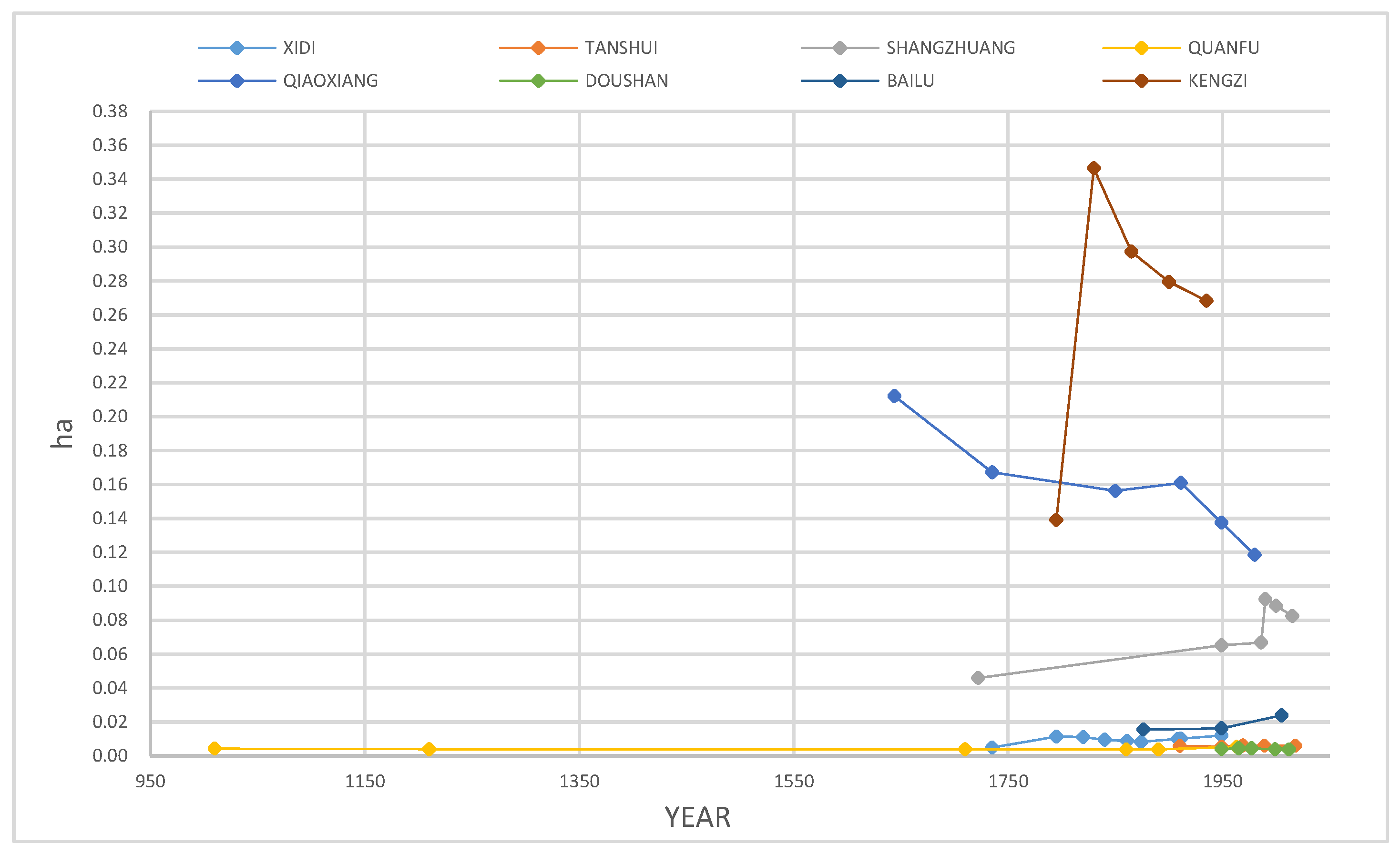





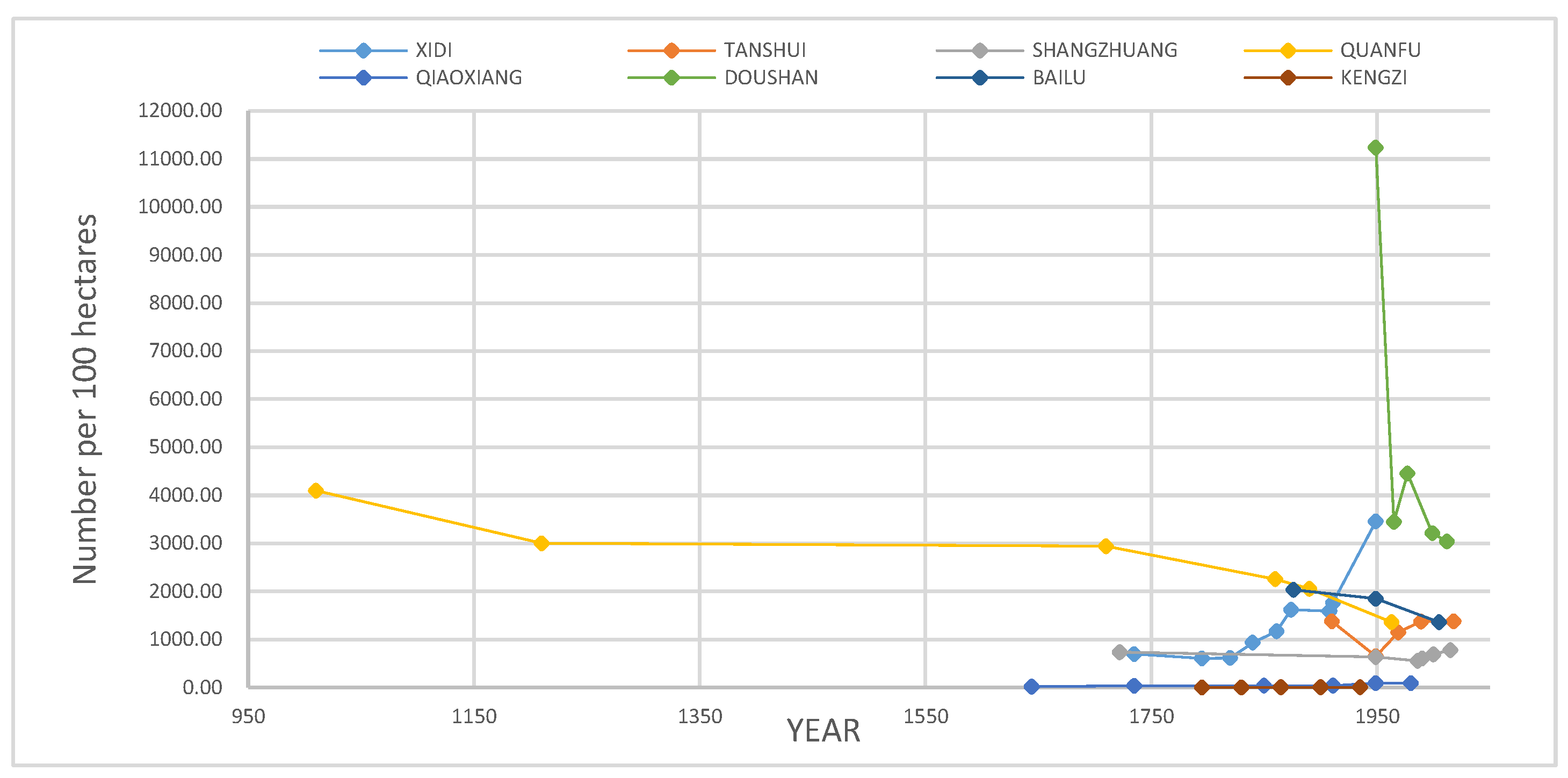




| Village | Scale of Its Smallest Bounding Rectangle | Year of Establishment | Spatial Expanding Mode |
|---|---|---|---|
| Shangzhuang | 516 m × 451 m | About 1470s | E+I |
| Doushan | 445 m × 300 m | About 1890s | E |
| Xidi | 681 m × 264 m | About 1050s | E+I |
| Bailu | 1315 m × 882 m | About 1150s | E |
| Tanshui | 1322 m × 676 m | About 1500s | O+I |
| Quanfu | 1565 m × 567 m | About 1010s | O+E |
| Qiaoxiang | 2527 m × 804 m | About 1500s | O+I |
| Kengzi | 5949 m × 4311 m | About 1690s | O |
| Metrics | Abbreviation | Description | Unit | ||
|---|---|---|---|---|---|
| Spatial texture | Patch Area | Mean | AREA_MN | The average area of all patches in the same category | Hectares |
| Standard Deviation | AREA_SD | Standard deviation of the area of all patches of the same class | Hectares | ||
| Euclidean Nearest-Neighbor Distance | Mean | ENN_MN | The average minimum distance between the individual patches. | Meters | |
| Standard Deviation | ENN_SD | Standard deviation of the minimum distance between each individual patches of the same class | Meters | ||
| Patch density | PD | The number of patches of the corresponding patch type divided by total landscape area, which facilitates comparisons among landscapes of varying size | Number per 100 hectares | ||
| Integral shape | Area | AREA | The patch area, which is the basis for many other indices | Hectares | |
| Fractal Dimension Index | FRAC | The fractal dimension describes the complexity and the fragmentation of a patch using a perimeter–area proportion. Fractal dimension values range between 1 and 2. Low values were derived when a patch had a compact rectangular form with a relatively small perimeter relative to the area. More complex and fragmented patches were associated with an increased perimeter and yielded a higher fractal dimension. | ----- | ||
| Shangzhuang | Doushan | Xidi | Bailu | Tanshui | Quanfu | Qiaoxiang | Kengzi | |
|---|---|---|---|---|---|---|---|---|
| Significance level-P (Valid: P < 0.05) | 0.881 | 0.912 | 0.007 | 0.153 | 0.757 | 0.081 | 0.007 | 0.037 |
| AREA_SD/AREA_MN | -- | -- | 0.93 | -- | -- | -- | 0.97 | 0.86 |
| Shangzhuang | Doushan | Xidi | Bailu | Tanshui | Quanfu | Qiaoxiang | Kengzi | |
|---|---|---|---|---|---|---|---|---|
| Significance level-P (Valid: P < 0.05) | 0.002 | 0.442 | 0.000 | 0.195 | 0.157 | 0.013 | 0.067 | 0.423 |
| ENN_SD/ENN_MN | 1.18 | -- | 1.18 | -- | -- | 1.83 | -- | -- |
© 2020 by the authors. Licensee MDPI, Basel, Switzerland. This article is an open access article distributed under the terms and conditions of the Creative Commons Attribution (CC BY) license (http://creativecommons.org/licenses/by/4.0/).
Share and Cite
Yang, X.; Song, K.; Pu, F. Laws and Trends of the Evolution of Traditional Villages in Plane Pattern. Sustainability 2020, 12, 3005. https://doi.org/10.3390/su12073005
Yang X, Song K, Pu F. Laws and Trends of the Evolution of Traditional Villages in Plane Pattern. Sustainability. 2020; 12(7):3005. https://doi.org/10.3390/su12073005
Chicago/Turabian StyleYang, Xi, Ke Song, and Fuan Pu. 2020. "Laws and Trends of the Evolution of Traditional Villages in Plane Pattern" Sustainability 12, no. 7: 3005. https://doi.org/10.3390/su12073005
APA StyleYang, X., Song, K., & Pu, F. (2020). Laws and Trends of the Evolution of Traditional Villages in Plane Pattern. Sustainability, 12(7), 3005. https://doi.org/10.3390/su12073005





